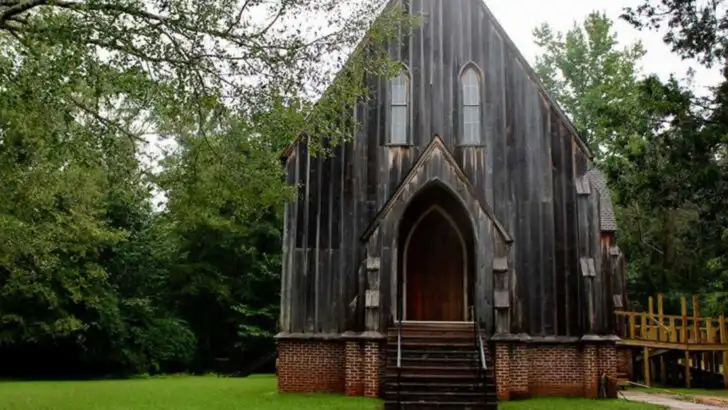The United States is home to numerous historic sites that once thrived with activity. Over time, some of these bustling locations have become surprisingly desolate.
This article explores twelve such sites, each with its unique charm and story. From once-vibrant factories to forgotten battlefields, these places offer a glimpse into the past, revealing changes in society and industry.
Despite their current emptiness, these historic sites continue to captivate visitors with their intriguing histories and the echoes of their once-busy days. Let’s delve into these fascinating relics of American history.
Centralia, Pennsylvania
In the heart of Pennsylvania lies Centralia, a town that once bustled with life. Today, it’s known more for its eerie desolation than its vibrant past.
In the 1960s, a coal mine fire ignited beneath the town, driving residents away. Streets now lie empty, with smoke wafting from underground.
Graffiti-covered roads and abandoned buildings paint a haunting picture of what once was. Despite its emptiness, Centralia draws in curious visitors intrigued by its history. A stark reminder of nature’s power, this ghost town exemplifies how quickly thriving communities can fade. The silence speaks volumes. A modern-day ghost story.
Bodie, California
Once a gold mining powerhouse, Bodie, California, echoes the Wild West era. This ghost town once teemed with prospectors hoping to strike it rich. Today, it’s frozen in time, its wooden structures and dusty streets whispering tales of yesteryears.
Preserved in a state of “arrested decay,” Bodie invites visitors to wander through history. The remnants of saloons, churches, and homes stand as testament to past ambitions.
This eerie yet captivating site offers a window into the boom-and-bust cycles of mining towns. Bodie’s story is one of dreams long abandoned, yet never forgotten.
Cahaba, Alabama
Cahaba, Alabama, was once the state’s capital before it fell into disrepair. This historic site is now an intriguing blend of ruins and nature’s reclaim. Crumbling brick structures stand amid lush greenery, hinting at its former significance.
Cahaba’s transformation from bustling capital to ghostly echoes is both haunting and fascinating. Seasonal flooding led to its abandonment, leaving behind a picturesque yet eerie landscape.
Visitors stroll through overgrown paths, exploring the remnants of a once-thriving community. Each brick tells a story of ambition and adversity, inviting contemplation on nature’s relentless progression.
Salton Sea, California
The Salton Sea in California paints a surreal picture. Once a bustling resort destination, it’s now largely abandoned, its shores lined with decaying structures and salt-crusted artifacts. Created by an accidental flood in 1905, it quickly became a haven for vacationers.
However, ecological issues led to its decline. Today, the stark landscape draws in photographers and adventurers. The scent of salt and decay lingers in the air, a testament to nature’s relentless cycle.
This site reminds us of the delicate balance between human ambition and environmental responsibility, as the sea’s eerie stillness quietly endures.
Virginia City, Montana
Virginia City, Montana, is a time capsule of the 19th-century gold rush era. Once filled with hopeful miners and merchants, its streets are now quieter, preserving the essence of a bygone era. The wooden facades and dirt roads transport visitors back in time.
This preserved ghost town offers insights into the rise and fall of mining communities. Authentic saloons, shops, and homes still stand, inviting exploration.
While tourism breathes some life into its dusty streets, Virginia City remains a poignant reminder of dreams pursued and lost. History lives on in every creak of wooden floorboards here.
Chetro Ketl, New Mexico
Chetro Ketl stands as a testament to the ingenuity of the Ancestral Puebloans. Once a thriving hub within Chaco Canyon, New Mexico, its stone ruins tell tales of architectural prowess and communal living.
This massive complex was a center for trade, religion, and politics in its time. Now, its grandeur is preserved in silence, with walls echoing past cultures.
Visitors wander through the remnants, marveling at the ancient stonework and expansive kivas. Chetro Ketl serves as a haunting reminder of a civilization’s rise and fall, leaving behind questions about its mysterious disappearance.
Rhyolite, Nevada
Rhyolite, Nevada, captures the wild spirit of the early 1900s gold rush. Founded in 1905, it quickly grew and then faded just as fast. Today, crumbling buildings punctuate the desert landscape, standing testament to past prosperity.
Once bustling with activity, Rhyolite now intrigues with its eerie stillness. The remnants of the bank, train station, and homes evoke stories of ambition and loss.
Visitors wander the deserted streets, reflecting on the transient nature of fortune. This ghost town’s haunting beauty lies in its stark contrast between past liveliness and present desolation.
Saint Elmo, Colorado
Saint Elmo, Colorado, is a ghost town nestled in the Rocky Mountains. This former mining hub thrived in the late 1800s, bustling with miners and merchants seeking fortune.
Today, its wooden buildings stand steadfast against the backdrop of towering peaks. Visitors are drawn to its rustic charm and stories etched in time.
Saint Elmo’s preservation offers a snapshot of frontier life, where dreams of gold once ruled. The town remains remarkably intact, inviting exploration amidst its serene silence. Each creak of the storefronts echoes the hopes and hardships of its past inhabitants.
Kennecott, Alaska
Kennecott, Alaska, is a symbol of industrial ambition in the remote wilderness. This abandoned mining camp once buzzed with activity, extracting copper from the rugged terrain.
Today, its towering red buildings stand silent against the backdrop of snowy peaks. Visitors explore this National Historic Landmark, marveling at the engineering feats accomplished in such a harsh environment.
Kennecott’s story reflects the challenges and triumphs of resource extraction in the early 20th century. As nature slowly reclaims the landscape, the site serves as a poignant reminder of humanity’s fleeting impact on untouched wilderness.
Roosevelt Roads, Puerto Rico
Roosevelt Roads in Puerto Rico once thrived as a bustling U.S. naval base. Covering 8,600 acres, it was a hub of military activity during its peak. Now, the base lies abandoned, with overgrown runways and empty hangars echoing past operations.
The site is a poignant reminder of geopolitical shifts and changing military strategies. Visitors find a haunting beauty in the juxtaposition of nature reclaiming man-made structures.
Roosevelt Roads stands as a relic of its time, offering insights into the factors leading to its closure. The silence of the empty base speaks volumes of its once vital role.
Glenrio, Texas/New Mexico
Glenrio straddled the Texas-New Mexico border, a bustling stop along Route 66. Once thriving with travelers, it now stands deserted, its vintage gas stations and motels relics of a bygone era.
This ghost town’s quiet streets and fading structures evoke nostalgia for the golden age of American road trips. Glenrio’s decline mirrors the fate of many Route 66 towns bypassed by modern highways.
Visitors explore the remnants, imagining the vibrant life that once filled these dusty roads. The town’s story is one of change and adaptation, where only echoes of the past remain.
Fort Jefferson, Florida
Nestled in the Dry Tortugas, Fort Jefferson is a massive coastal fortress once bustling with soldiers. Built in the mid-1800s, it was vital for protecting shipping routes. Now, it stands isolated, surrounded by turquoise waters and palm trees.
Visitors arrive by boat, drawn to its impressive architecture and unique location. The fort’s empty corridors and expansive grounds speak of military history and strategic importance.
Fort Jefferson’s solitude offers a reflective space where history and nature intertwine. The site serves as a testament to the ingenuity and challenges of constructing such a monumental structure in a remote location.

